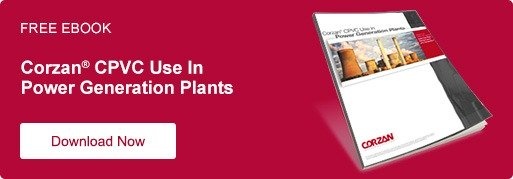Why CPVC is Used For Power Generation Plants
This post is an excerpt from the free downloadable ebook, CPVC Use in Power Generation Plants. Access the full eBook.
Power generation plants of all types—from gas turbine combined cycle to nuclear to combined heat and power—all require the movement of large amounts of water and handle caustics and corrosives.
Unfortunately, due to the nature of the chemicals used and levels of heat and pressure involved, there are few pipe, valve, fitting, ducting and tank liner material choices available that can provide long-term reliability.
That said, judiciously assessing these material options on a system-by-system basis can directly increase operational efficiency, minimize downtime and improve bottom-line performance.
CPVC Optimizes Power Generation Plant Performance and Reliability
Corzan® CPVC is a specialized, high-performance thermoplastic designed for use in aggressive industrial environments, including power plant systems. Unlike other thermoplastics (i.e. PVC), Corzan CPVC stands up to heat and pressure while offering superior resistance to corrosives and caustics. In addition, its lightweight and easy joining process can generate substantial installation savings.
Specifically, Corzan CPVC can:
- Eliminate internal and external corrosion concerns.
- Reduce installation time and costs.
- Lower life-cycle costs, as well as maintenance and corrosion monitoring.
- Provide excellent hydraulic capabilities.
- Minimize total system costs with stable material prices.
In addition, Corzan piping is available in diameters up to 24 inches to satisfy most power plant requirements.
Corzan CPVC Stands Up to the Most Aggressive Chemicals
Corzan CPVC provides superior, long-term resistance to corrosive chemicals, seawater and demineralized water, even at high temperatures. In fact, CPVC pipes and fittings effectively stand up to most acids, bases and salts. It can also reliably handle the aggressive chemicals commonly encountered in power generation plants, including:
- Hypochlorite
- Caustic soda
- Sulfuric acid
- Sodium sulfite
- Ferrous chloride
- Ferric chloride
- Hydrogen sulfide
- Alum
Installation Advantages
From an installation perspective, Corzan CPVC offers significant opportunities over metals. All metal piping requires a complex welding process, which includes:
- A designated welding area.
- Costly hot work permits.
- An experienced, certified welder.
- Weld x-rays.
It’s a long, labor-intensive process that can prove costly for power plants. In addition, metal is heavy, which complicates moving the material around a plant and securing it in place.
Conversely, CPVC is lightweight, allowing it to be easily moved around a facility, often without specialized machinery. It can also be easily joined using two primary methods:
- Solvent Cement: Solvent cement can be applied anywhere without heat or flame. It molecularly fuses the CPVC material together, creating a strong joint. New plant construction or large system updates benefit most from solvent cement installations.
- Mechanical Coupling: Mechanical couplings can join CPVC to CPVC or CPVC to any other piping material, including metal. This method is great for immediate piping repairs where timely replacement can limit the cost of system downtime.
Want More Information on Corzan CPVC’s Use in Power Generation Plants?
The full ebook contains even more information on power generation plant applications, including:
- Where CPVC can be used in power plants.
- System specific applications where CPVC surpasses other materials from a performance and cost standpoint.
- Three specific instances within a power generation plant where CPVC can generate value both in the short and long term.
- Reasons existing power plants and new power plants turn to CPVC over other materials.
To learn more about Corzan CPVC in power generation plant applications, download the free ebook today.


